The process of building the International Space Station - The great cooperation of mankind!
Have you ever looked at the starry sky and suddenly caught a glimpse of a glimpse? If it did not flicker, you would have had the honor to see one of the greatest feats in the history of humanity cooperation with the International Space Station.
Almost the size of a house with 6 bedrooms and weighing more than 320 cars, the International Space Station is so large that no rocket can put it into orbit. Instead, people assemble each piece while it soars in space at a speed of 28,000 km / h, equivalent to flying around the Earth in just 90 minutes.


The International Space Station is so large that no rocket can ever put it into orbit.
The beginning was when 16 countries signed the Intergovernmental Space Station Agreement. Tasks are assigned to each country for the ISS, from modules and maintenance work, to information and financial sharing. Estimated at US $ 100 billion, the Space Station is the most expensive thing ever made.
The whole world watched when a Russian rocket launched the first ISS module into the sky.Zarya , equipped with two solar panels and a propulsion system has an important task to prevent the young space station from crashing into Earth, keeping a safe distance of 400 km.
The US space shuttle Endeavor followed two weeks later, bringing with it Unity , a button module that connects other modules and an international assembly of 6 people. Then comes the Zvezda module, which provides communication and accommodation facilities.
The year 2001 saw the arrival of Destiny , the first of four research modules, where astronauts spent about 36 hours a week conducting gravity experiments.

Destiny module.
The Destiny module also controls the seven-joint Canadarm2 robotic arm , capable of moving a mass of more than 100,000kg. It is very suitable for unloading new shipments from space shuttle.
2001 was a busy year for ISS because of the addition of the Quest module , the main pressurized compartment for space travel and Pirs , a docking port for Russian spacecraft, including emergency rescue ships. Soyuz is always ready.
Since the first visitors landed on the ISS, the station has been continuously occupied, having hundreds of guests with an average stay of 6 months. Their schedules are filled with exercise, two hours a day to avoid muscle loss, maintain and repair the station, and communicate with family or extraordinary minds around the world. But they still have leisure time, often have movie nights and even shoot the first music video in the universe.
In February 2003, after bringing the research modules to the ISS, the Columbia Space Shuttle exploded upon flying back to Earth, claiming the lives of seven astronauts. After a four-year hiatus, the work was quickly catching up with more centers, pressurized bays, ports and an observation deck for 360-degree views of our world and the world outside. Other important components include pedestals and platforms that support the radiator and solar panels to provide enough electricity for 55 houses.

ISS International Space Station - the greatest feat in human history.
It took 10 years and more than 30 missions and the International Space Tram finally completed , ending the American Space Shuttle Program. The ISS Space Station continues its mission to serve as an excellent demonstration of international cooperation. Currently, some astronauts are allowed to stay on the ISS longer, so that scientists can learn about the long-term effects on body and psychology while in space, which will be very useful for space travel ambitions are getting bigger and bigger, like traveling to Mars.
Throughout the history of ISS, we have not only acquired a great deal of scientific knowledge but also learned how to work together to achieve great achievements.
- November 20, 1998 - The first module of ISS International Space Station flies into space
- History of the International Space Station through photos
- Visit 'the longest road' on the ISS International Space Station
- Russia - America started building new houses on the universe
- How big is the International Space Station (ISS)?
- 16 countries 'capital contribution' to set up an International Space Station
- Russia - America cooperated to build a space station on the Moon
- International space station increased altitude by 2km
- NASA opened the International Space Station for ... tourists and film makers from 2020
- Russian space station will replace the US ISS global surveillance
- The Russian House of Representatives ratified the agreement on space cooperation with Vietnam
- The uncertain future of the ISS space station when NASA returns to the Moon
 Norway built the world's tallest wooden tower
Norway built the world's tallest wooden tower Kremlin
Kremlin Ashurbanipal: The oldest royal library in the world
Ashurbanipal: The oldest royal library in the world Decoding the thousand-year construction of Qin Shihuang shocked the world
Decoding the thousand-year construction of Qin Shihuang shocked the world